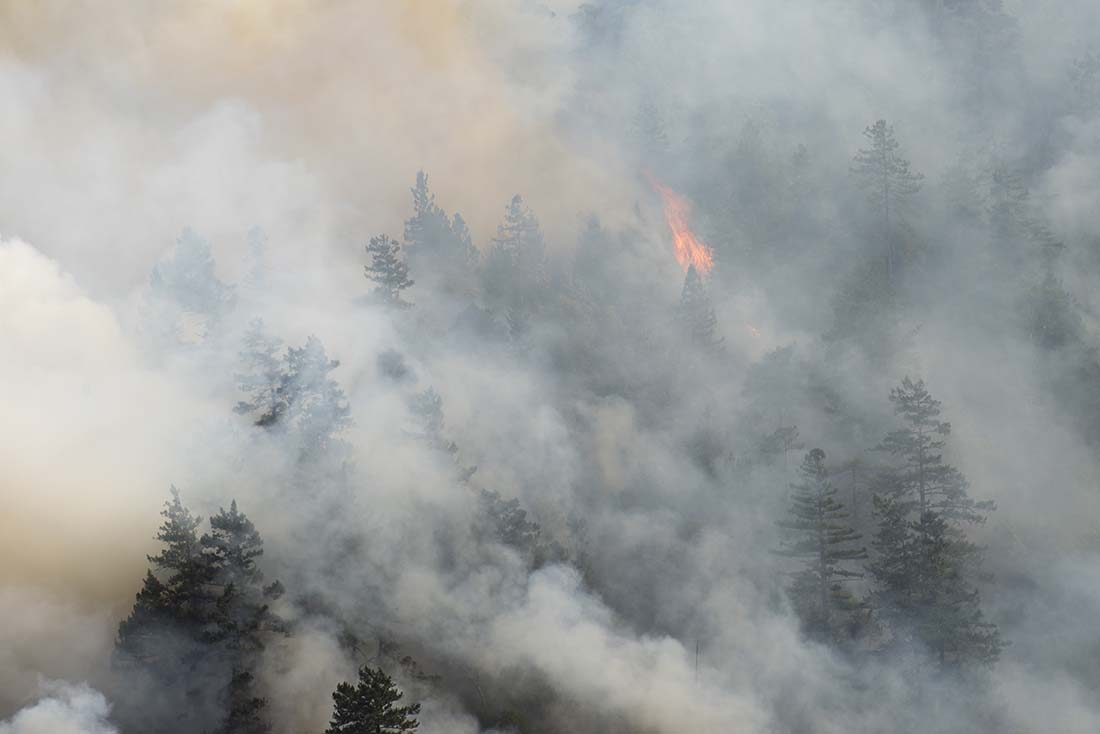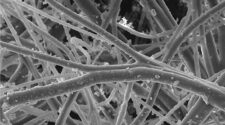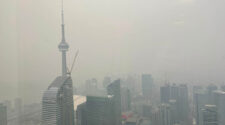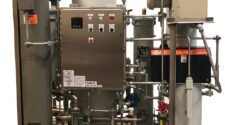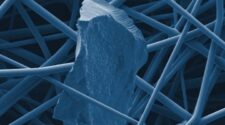The wildfire season kicked off early this year, with infernos raging from Texas to Australia. The Texas
Panhandle and parts of Oklahoma are now recovering from the record-breaking devastation of the Smokehouse Creek wildfire – the largest fire in Texas history that has already consumed a staggering million acres. Massive wildfires have become annual events, starting earlier and lasting longer. Meanwhile, wildfire smoke travels by wind, affecting air quality, visibility, and atmospheric chemistry of places thousands of kilometers away from the original locations of wildfires.
In June 2023, in the wake of 500 ongoing wildfire events in Canada, heavy smoke and particulate emissions blanketed major parts of the northeast and north-central United States, resulting in some of the most polluted days on record and affecting some 122 million people. In late June 2023, the smoke crossed the Atlantic, reaching Europe, and furthering its impact.
Wildfire projections indicate an impending shift to a temperature-driven global fire regime in the 21st century, creating an unprecedentedly fire-prone environment globally and increasing health risks, as well as societal and economic burdens. With the rise in global wildfire activities, maintaining indoor air quality (IAQ) is critical for ensuring safe and healthy building occupancy. Such a rapidly emerging requirement points to the need for climate adaptation and demands science-based climate resilience solutions that balance human health with building energy efficiency, climate footprint, and other sustainability parameters.
Wildfire Smoke Composition and Its Health Effect
Biomass burning emits large amounts of toxic trace gases and particulate matter (PM) into the atmosphere. According to the EPA’s National Emissions Inventory (NEI) estimate from the EPA, wildfires and prescribed burns are the largest source of PM2.5 emissions in the U.S, accounting for as much as ~30% of total emissions across the continental U.S., and up to half of total PM2.5 on an annual basis in the Western U.S., compared with 9.2% from transportation sources.
The exact composition of a wildfire’s smoke depends on numerous factors, including the incinerated material (e.g., type of biomass, building materials, plastics, waste, etc.), the conditions under which it is burnt, ambient temperature, and weather conditions. The size distribution of smoke PM is vastly below 300 nm (PM <0.3 μm), and its composition is largely comprised of organic compounds (over 90%), followed by elemental carbon (roughly 5–10% by weight) and other inorganic elements. In addition, wildfires emit hundreds of volatile organic compounds (VOCs) such as formaldehyde, acrolein, and poly-aromatic hydrocarbons (PAHs), which can subsequently contribute to the creation of ozone and secondary organic aerosols.
Moreover, recent studies show that wildfire smoke supports the transport of bioaerosols, composed of fungi, bacteria, their metabolic byproducts, and even seeds and plant matter. Not surprisingly, most of the microorganisms in the smoke remain viable. After all, fires and smoke have been a natural phenomenon and an important means for the spread of life on this planet for billions of years.
Such an array of complex pollutants capable of traveling long distances and infiltrating into buildings has dire consequences on human health. Indeed, multiple studies highlight the health risks associated specifically with exposure to wildfire smoke: increased respiratory morbidity, cardiovascular mortality, respiratory emergencies, hospital admissions, and out-of-hospital cardiac arrests. Emerging data further links wildfire smoke to reduced birth weight and increased systemic inflammation. Importantly, the adverse health effects of wildfire smoke is largely attributed to submicron smoke particles. Recent studies indicate that the toxicity of wildfire smoke PM can be higher than “conventional” PM2.5 originated from, for example, automotive and stationary emission sources.[1]
Wildfire Smoke Monitoring and IAQ
Current recommendations for wildfire smoke exposure are based on previously established guidelines for non-wildfire PM, specifically PM2.5, and their pollution levels are reported in terms of mass concentration, typically in μg/m3. During wildfire episodes, daily PM values can skyrocket to around 800 μg/m3 or more, a stark contrast to the EPA’s primary 24h PM standard of 35 μg/m3. Even though submicron particles dominate the wildfire smoke in terms of particle count, their mass contribution to PM2.5 becomes less prominent in the presence of larger particles.
Consequently, the significance and contribution of wildfire smoke submicron particles are poorly understood when using a PM2.5-based air quality framework for assessing ambient and indoor air quality. Submicron particles may be more potent than larger particles on an equal mass basis. This may be due in part to a much higher particle count concentration and combined particle surface area. For submicron particles, at a given mass concentration, a decrease in size results in a steep increase in PM count and surface area per unit mass.
Recent research highlights that the size-resolved PM characterization and their composition are important for identifying clear relations between smoke exposure and health effects. Smoke particles
demonstrate highly reactive surface chemistry and adsorb many toxic organic compounds and reactive oxygen species. Their large surface area and ability to enter the bloodstream due to their small size are the two most significant characteristics that make them more toxic than larger particles. Given their large number and surface area, it is important to characterize their number concentration. Consequently,
particle counts in the appropriate size range should be adopted more broadly.
HVAC Filters Characterization for Smoke Protection
Currently, HVAC filters are commonly used for PM removal in both residential and commercial indoor environments. Their PM removal efficiency largely depends on the material properties of the filter media, followed by filter geometry and HVAC system configuration and runtime.
HVAC filters are tested using ASHRAE Standard 52.2 (or EN779 in Europe). ASHRAE Standard 52.2 classifies the single-pass particle removal efficiency of HVAC filters based on the minimum removal efficiency for three broad particle size bins (0.3–1, 1–3, and 3–10 μm) using inorganic salts, such as KCl or NaCl particles, in a laboratory test facility (ASHRAE, 2017). The minimum removal efficiency value among these three size bins is then used to assign an HVAC filter its efficiency rating, called the Minimum Efficiency Reporting Value (MERV).
In general, increasing MERV ratings lowers indoor PM concentrations. Specifically for wildfire smoke, MERV 11 or higher filters are typically recommended. Most MERV 11 and 13 HVAC filters in use today rely on electret filter media. These electret filters are electrostatically charged polymer-based filters that exhibit higher filtration efficiency (at least initially) and low airflow resistance compared to purely mechanical filters. Given the appropriate filter geometry, a filter manufactured with electret filter media provides cost and HVAC energy savings advantages, compared with pure mechanical filters.
But, can we rely on HVAC filters for protection against wildfire smoke?[2] Limited information existed about the size-resolved filtration efficiency of a filter media using a representative sample of wildland fuel smoke, e.g. pine needles or wood chips. A recent study on the subject tries to bridge the knowledge gap.[3]
Current MERV ratings do not account for PM < 0.3μm when evaluating particle removal efficiency and are thus far from representing the typical size distribution of wildfire smoke particles. Furthermore, the general knowledge of the filtration efficiency of submicron particles is based on laboratory studies using inorganic salts, dioctyl phthalate (DOP), or other analytes that are vastly different from smoke.
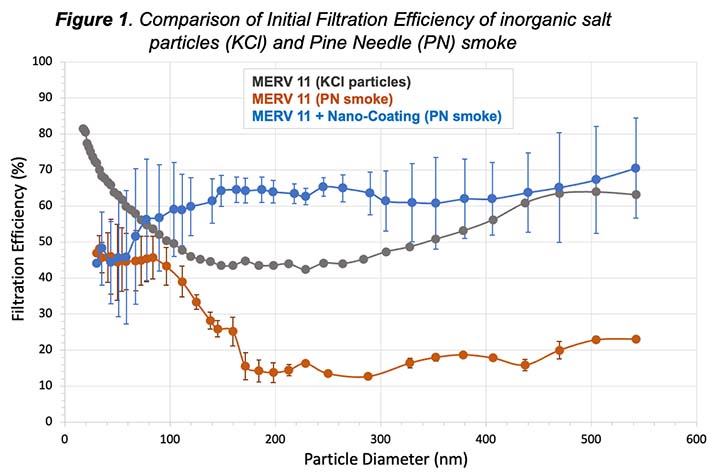
Based on the conventional understanding of particle filtration, the filtration efficiency of smoke particles should increase sharply below the 0.3 μm particle size range – the most penetrating particle size (MPPS) range of most filters – as illustrated in the test result in Figure 1 (gray trace, electret MERV 11 tested with KCl).
It turned out, however, that the pine needle smoke (PN) – an analogous surrogate for wildfire smoke – filtration efficiency of electret media was significantly lower than expected based on its designated MERV rating (Figure 1, orange trace, MERV 11 tested with PN) and follows an almost zero linear trend for much of the relevant smoke particle size range.[3]
Recent research found that an application-specific, nano-architectured coating, when applied to the media, can stabilize the electret media charges in the presence of smoke and boost the smoke filtration
efficiency of the base media by more than 3x (Figure 1, blue trace, MERV 11 coated with nano architecture coating and tested with PN smoke).
Aging Effect
Testing only the initial filtration efficiency misses an important parameter for assessing media performance over its useful life. This is an especially key consideration in the case of electret filters, as exposure to environmental factors can have a detrimental effect on their long-term performance. Recent studies demonstrate that smoke loading (aging) leads to a significant decrease in filtration efficiency for most particle sizes, but especially in the relevant submicron range.
One study of air cleaners equipped with electret air filters found that the clean air delivery rate (CADR) for smoke was reduced by 95% after the deposition of only 10 mg of PN smoke on the filter.[2] In a recent study, when MERV-11 electret media was aged with PN smoke, its filtration efficiency against smoke was further reduced from the above-shown initial levels (Figure 1, orange trace, MERV 11 tested with PN).[3] In contrast, the same media with the nano-architectured coating improves filtration efficiency with smoke loading.
Fiber-Smoke Interactions
Smoke particles are characterized by a complex composition, including solid (e.g., black carbon) and a large fraction of liquid/oil-like organic phases (e.g., semi-volatile organic compounds, SVOCs). The dynamics of the liquid and solid particle filtration differ significantly due to the differences in deposition modes (dendritic structures formed by solid particles vs. film formation by liquids), collision kinetics, and differences in the particle/fiber surface interactions.
Scanning Electron Microscopy (SEM) can provide insights into how different pollutants interact with the filter media (Figure 2). In the case of mostly inorganic, solid particles, the dendritic-type deposition morphology is commonly observed, while in the case of smoke particles, the fibers’ surface is found to be covered with droplets resembling “beads on string” morphology. This type of morphology is frequently observed for liquid-phase organic aerosols.
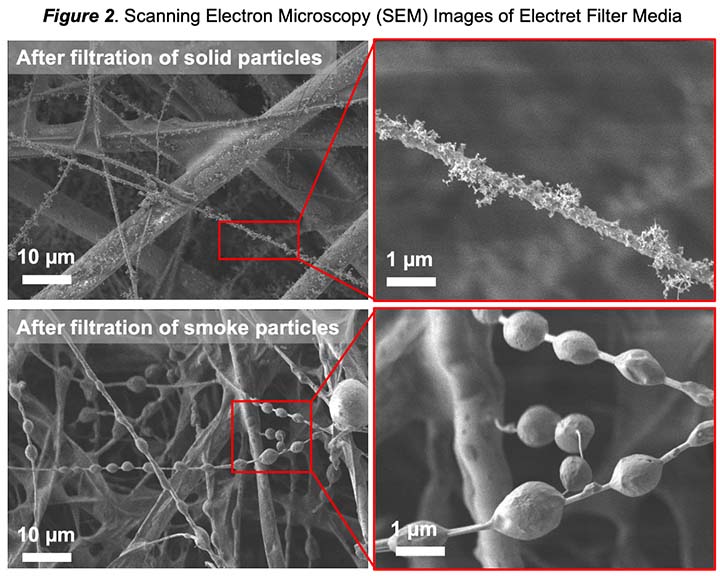
The presence of oil in the particle causes a reduction in the media’s filtration efficiency in comparison to solid particles of the same size. Hence, solely relying on salt particles in standardized testing methods for evaluating the performance of filters is insufficient in the context of real-world HVAC systems challenged with environmental pollutants such as smoke particles.
Future Outlook
Current recommendations for preserving good IAQ during wildfire smoke events include HVAC filter upgrades and the use of air cleaners. For HVAC systems, the correlation between MERV ratings and smoke removal efficiency is a key factor for improving IAQ solutions. These include accurate IAQ assessment and monitoring that considers both particle counts and mass concentrations across various size ranges and testing filters’ filtration efficiency using smoke particles in a relevant, application-based context.
It is equally important to understand the mechanisms and interactions of smoke with filter media since they determine the filtration efficacy. The development of standardized measurements that are relevant for specific applications is necessary to promote better understanding and drive the innovation of solutions.
In summary, a better appreciation and further research of filter media testing and rating, ambient pollution sources and levels of PM2.5 versus PM <300 nm measurement and reporting, and particle removal efficiencies of commercial filter media in these particle size ranges, in combination with the assessment of relevant standards and guidelines, the corresponding energy impact of various filter media and filters are necessary for informing filter selection and recommendations for countering increasingly challenging real-world IAQ problems. Meanwhile, stand-alone, high-efficacy air cleaners can be an
effective add-on solution, despite common drawbacks, including maintenance hassles and costs.
References:
- Aguilera, R. et al. “Wildfire smoke impacts respiratory health more than fine particles from other sources: observational evidence from Southern California.” Nat Commun 12, 1493 (2021). https://doi.org/10.1038/s41467-021-21708-0].
- A. L. Holder et.al. “Impact of do-it-yourself air cleaner design on the reduction of simulated wildfire smoke in a controlled chamber environment,” Indoor Air, vol. 32, no. 11, p. e13163, 2022, doi: 10.1111/ina.13163.
- Shirman et al. “Evaluation of Filtration Efficiency of Various Filter Media in Addressing Wildfire Smoke in Indoor Environments: Importance of Particle Size and Composition” Atmosphere 2023, 14(12), 1729. https://www.mdpi.com/2073-4433/14/12/1729]


